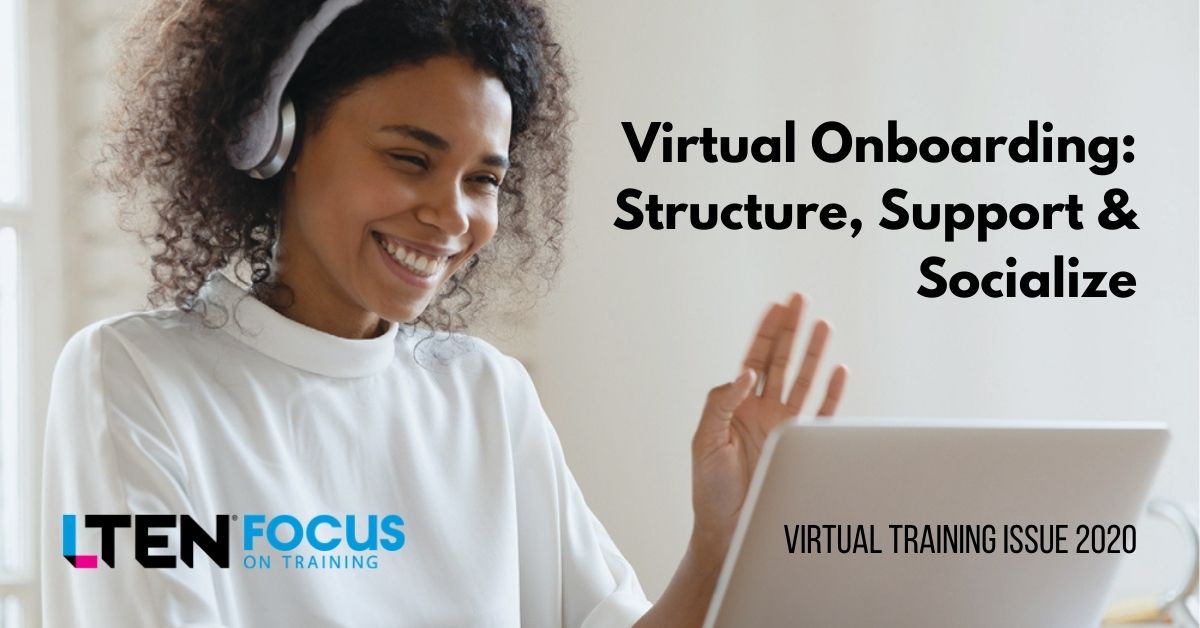
Virtual Onboarding: Structure, Support & Socialize
FEATURE STORY – By Briony Frost
What do we need to start, stop and continue doing to ensure virtual onboarding is a success?
 Onboarding is notoriously challenging. Done well, it saves time, money and resources,
Onboarding is notoriously challenging. Done well, it saves time, money and resources,
and improves new-hire success and retention. Done badly, it spans a spectrum from irrelevant and tedious to costly and aversive, potentially sending new hires looking for the company’s escape hatch.
The recent forced move to virtual onboarding has created additional challenges. Many organizations now realize their onboarding relies not only on planned events and resources, but also on informal interactions between colleagues that they may not yet know how to replicate. Lessons learned during lockdown, as well as from location-neutral employers, offer insights into how to smoothly transition new hires into newly virtual teams. So, what do we need to start, stop and continue doing to ensure virtual onboarding is a success?
Structure
According to global analytics firm Gallup, it takes 12 to 18 months to fully integrate a new hire. But organizations typically give new employees only 90 days to prove themselves. Onboarding is a vital tool to bridge that gap as, according to management professor Tayla N. Bauer, Ph.D., “the faster new hires feel welcome and prepared for their jobs, the faster they will be able to successfully contribute to the firm’s mission.” Having a structured onboarding program, with appropriately timed and sequenced activities, organizational role models and shared milestones at 30, 60 and 90 days is essential.
What is even more important – especially for virtual teams – is that onboarding feels purposeful, coherent and relevant to everyone. Recent research into virtual onboarding by Libby Hemphill and Andrew Begel finds all staff are now facing unfamiliar “personal, social, structural, technological and operational challenges.”
It may seem straightforward to convert face-to-face meetings, events and administrative tasks into virtual calls, e-learning modules and emails, but a “onesize-fits-all” approach may not be appropriate, and onboarding should be tailored to meet individual needs.
Tips for structuring your virtual onboarding to maximize effectiveness include:
Create a Roadmap
Do your new hires know what their onboarding will look like from start to finish, including tasks, task order and milestones? A clear virtual roadmap is vital when potential disorientation is amplified by lack of copresence. It also helps newcomers to navigate information and plan onboarding activities alongside their day-to-day work, boosting confidence and speeding up self-efficacy development.
 Join the Dots
Join the Dots
Make sure that onboarding activities are overtly connected to each other and to on-the-job learning, mentoring practices and meetings with key personnel. Explicit connections clarify and reinforce role-related understanding and build a stronger picture of your organization’s culture and values.
Make It Flexible
The virtual realm is valuable for creating onboarding routes tailored to individual roles because there is greater scope for on-demand delivery. Being flexible in how new hires approach onboarding will help to make training feel more relevant, improve engagement and motivation and enable them to prioritize the right projects at the right moment to achieve all-important early successes.
Support
Newcomers have a steep learning curve when they first enter your organization. They need to understand how to apply their existing knowledge and competencies to the job tasks, the organization’s structure and culture, how their role fits in, their team’s routines and practices and how to grow within the organization. They may also need to invest in training to close knowledge gaps or enhance skills.
Ways to help them proactively obtain the full benefit from onboarding include:
Information Gathering
Thought should go into enabling new employees to find things out for themselves. Take a fresh look at your digital platforms: are they organized, navigable and accessible? What about communications? Are your newcomers listening to static or struggling to pick signal out of the noise? Most importantly, do they know where and who to go to for help?
In fully and partially virtual teams, Hemphill and Begel note, “geographic separation hinders help-seeking by making it more difficult for team members to understand one another’s areas of expertise.” Peer mentors and support networks need to be clearly signposted and forged from suitable teammates who are willing and able to answer questions.
First Impressions
That stroll down the corridor together to meet another colleague or client where you can get your new hire up to speed on the person and the context is no longer happening, so be sure to cover this virtually. Be clear too about company expectations on virtual behaviors. Is there a dress code? Should the camera and microphone be on or off? Do you raise a digital hand or just speak up?
Having a shared code of conduct, management scholars J.E. Galvin and Manju K. Ahuja argue, counteracts the reduction in social cues during remote working, such as body position, subtle expressions and movements that people exhibit when face-to-face. It is good practice for supporting inclusivity too.
Relationship Development
The virtual realm can enhance connectedness or leave new hires feeling forgotten, ignored or irrelevant. Reduce staff turnover by:
- Providing opportunities to outline with managers and peers how a newcomer’s role relates to the company’s strategy and how they can make a difference.
- Reproducing informal networking and learning opportunities, such as meet and greets, shadowing and fieldwork.
- Creating spaces to enable informal, spontaneous communications to take place that can reinforce the formal onboarding program and establish a sense of belonging.
Seek Feedback
Feedback is a dialogue. It should cover not only new-hire progress and performance, but also clarify role-related expectations and provide insights into the onboarding experience. Create virtual one-to-ones with new hires and managers, develop robust and consistent mentoring programs and seek feedback on onboarding programs to enhance first-year integration.
Show Success Early On
Does your new employee understand what success looks like? Review and discuss the criteria for success in the role, taking into account any changes to working practices, timelines and approaches created by COVID-19 adjustments. Make sure you arrange regular catch-ups to review progress with them.
Socialize
New hires may already be accustomed to remote working. But doing so in a familiar role is different from joining a new team, company and post. A few simple techniques can ensure that new staff feel engaged, included and motivated.
Connect
Set up regular touch points within teams and across the organization to re-establish shared visions and mission, reinforce networks and meet new people. Encourage everyone to use their webcam or a good profile photo to increase connectedness.
Compete
Quizzes, board games, escape rooms, murder mysteries and more translate well into digital forms, offering fun, challenging and relevant ways to reinforce understanding, identify knowledge gaps and develop networks. Team games, played with breakout rooms, are particularly good for helping newcomers to connect with colleagues.
Chat
Provide chat channels for informal, social interactions to help virtual team members touch base on current work, challenges and collaboration opportunities, facilitating better coordination, trust and conflict resolution. Non-work discussion enables newcomers to be accepted more quickly when shared interests are identified. Chat further facilitates productive help-seeking behavior as new hires feel more confident approaching people with whom they are familiar and comfortable.
Celebrate
Showcasing examples of successful activities by celebrating the work of teams and doing “show and tell” team or company-wide activities helps to orientate new hires to the culture and expectations. It helps everyone feel valued and supports longer-term staff retention too.
Briony Frost, Ph.D., FHEA, is a learning design and development specialist at OPEN Health. Email Briony at brionyfrost@openhealthgroup.com.
Fall 2020 – Virtual Training








